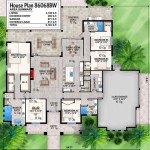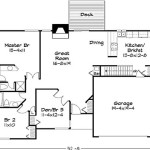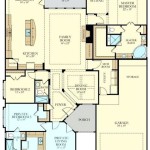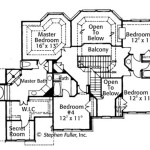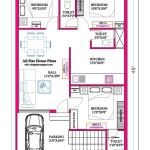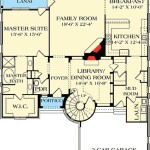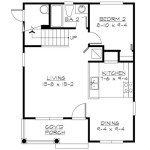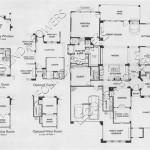2 Bedroom Home Plans With Basement: Maximizing Space and Value
The rising cost of land and construction materials has led to increased interest in efficient and versatile home designs. Two-bedroom home plans with a basement offer a viable solution for maximizing living space without significantly increasing the building footprint. These plans are particularly attractive for first-time homebuyers, small families, empty-nesters, or individuals seeking a manageable property that can be adapted to changing needs over time.
This design strategy utilizes the basement as a functional extension of the main living area, expanding the home's overall square footage and providing valuable storage, recreational, or even additional living space. The basement’s potential elevates the value of a two-bedroom home plan, making it a practical and financially sound investment.
A well-designed two-bedroom home with a basement can cater to diverse requirements, from a starter home to a retirement haven. The adaptability of the basement allows homeowners to customise their living environment to suit their lifestyle and preferences, making it a worthwhile option for various demographic groups.
The Benefits of a Basement Foundation
A basement foundation provides a multitude of advantages that extend beyond simply increasing living space. These benefits can impact the home's energy efficiency, structural integrity, and overall value.
One of the primary benefits is improved thermal performance. The earth surrounding the basement walls acts as a natural insulator, helping to maintain a more consistent temperature throughout the year. This can lead to reduced heating and cooling costs, particularly in climates with extreme temperature fluctuations. The regulated temperature also enhances the comfort level within the home.
Another critical aspect is the enhanced structural integrity of the home. A basement foundation provides a solid and stable base for the entire structure, protecting it from soil movement and potential damage caused by weather conditions such as heavy rain, snow, and winds. The deep foundation can also minimize the risk of settling or cracking in the walls and floors of the house above.
Furthermore, basements can serve as a safe haven during severe weather events, such as tornadoes or hurricanes. The below-ground location offers increased protection from high winds and flying debris, making it a valuable safety feature for homeowners in vulnerable areas. The presence of a basement can significantly increase peace of mind during such events.
From a practical standpoint, the accessibility of utilities is greatly improved with a basement. Plumbing, electrical wiring, and HVAC systems can be easily accessed and maintained within the basement’s confines. This streamlined accessibility simplifies repairs and upgrades, saving time and money in the long run. Moreover, the concealment of these systems contributes to a cleaner and more aesthetically pleasing appearance in the main living areas.
Resale value is often positively impacted by the presence of a basement. Even an unfinished basement increases the potential living area of the home, making it more appealing to potential buyers. A finished basement further enhances the value by providing additional living space that can be used for bedrooms, recreation rooms, or home offices, thus increasing the overall marketability of the property.
Designing Functional Two-Bedroom Home Plans With Basement
Creating a functional and comfortable two-bedroom home plan that effectively incorporates a basement requires careful planning and consideration of various factors. The design should maximize the use of space, ensuring that both the main living areas and the basement are efficiently utilized.
The layout of the main floor should prioritize open living spaces and natural light. A combined living room and dining area can create a sense of spaciousness, while strategically placed windows can brighten the interior and connect it to the outdoors. The kitchen should be efficiently designed with ample storage and counter space, optimizing workflow and functionality. Consider incorporating an island or peninsula to provide additional workspace and seating.
The bedrooms should be thoughtfully positioned to ensure privacy and comfort. The master bedroom should ideally be located away from the main living areas, providing a quiet retreat for relaxation. The second bedroom can be used for guests, children, or as a home office. Both bedrooms should have ample closet space and access to a well-appointed bathroom.
Staircase placement is crucial to the overall flow of the home. The staircase leading to the basement should be conveniently located near the main living areas, allowing for easy access to the lower level. Consider the staircase's width and design to ensure safety and comfort. A wider staircase can make it easier to move furniture and other items to and from the basement.
The design of the basement should be adaptable to various uses. If the basement is intended for recreational purposes, consider creating an open floor plan that can accommodate a home theater, game room, or gym. If the basement is intended for additional bedrooms, ensure that it has proper egress windows to meet building code requirements. Adequate lighting and ventilation are also essential to creating a comfortable and livable basement space.
The design must address moisture control. Proper waterproofing is essential to prevent water damage and mold growth in the basement. This includes installing a vapor barrier, sealing cracks in the foundation walls, and ensuring proper drainage around the perimeter of the home. A dehumidifier can also help to maintain a comfortable humidity level in the basement.
Consider the inclusion of a basement bathroom. Adding a bathroom to the basement can significantly increase its functionality and convenience. This is particularly useful if the basement is being used as a recreation room or guest suite. The bathroom should be properly ventilated to prevent moisture buildup and mold growth.
Maximizing Basement Potential: Finishing and Design Ideas
Finishing a basement transforms it from a rudimentary storage space into a valuable extension of the home. The finishing process involves insulating the walls, installing flooring, adding lighting, and completing any necessary plumbing or electrical work. This investment considerably increases the livable square footage and provides opportunities to customize the space to suit the homeowner's specific needs.
A popular option is to create a recreation room or family room in the basement. This can be a versatile space used for watching movies, playing games, or simply relaxing with family and friends. Comfortable seating, a large television, and a sound system can transform the basement into a home entertainment center. Consider adding a wet bar or kitchenette to enhance the functionality of the space.
Another common use for a finished basement is as a home office. In today's increasingly remote work environment, a dedicated office space can be invaluable. A well-designed home office should have ample desk space, comfortable seating, and adequate lighting. Soundproofing the walls can help to minimize distractions and create a more productive work environment. High-speed internet access is also essential.
Basements can also be transformed into guest suites. This is a great option for homeowners who frequently host visitors. A guest suite should include a comfortable bedroom, a private bathroom, and a small seating area. A separate entrance can provide added privacy for guests. Egress windows are essential to ensure the safety of guests in the event of an emergency.
Home gyms are another popular use for finished basements. Dedicated exercise rooms provide a convenient and private space for working out. The space should be equipped with appropriate flooring, such as rubber mats, and ample lighting. Consider adding mirrors to the walls to improve form and technique. A sound system and television can help to keep you motivated during workouts.
For homeowners with hobbies, a finished basement can provide a dedicated space for pursuing those passions. This could be a workshop for woodworking, a studio for painting, or a room for crafting. The space should be designed to accommodate the specific needs of the hobby, with adequate storage, lighting, and ventilation. It's important to plan the layout to ensure proper organization of tools and materials.
When designing a finished basement, it is important to consider the overall aesthetic of the home. The basement should complement the style and décor of the main living areas. Choose flooring, paint colors, and furniture that blend seamlessly with the rest of the house. Consider adding personal touches, such as artwork, photographs, and decorative items, to create a warm and inviting atmosphere.
Lighting plays a crucial role in creating a comfortable and functional basement space. Natural light can be limited in basements, so it is important to incorporate a variety of artificial lighting sources. Recessed lighting provides general illumination, while task lighting can be used to highlight specific areas, such as desks or workbenches. Accent lighting can be used to add visual interest and create a cozy atmosphere. Consider using energy-efficient LED lighting to save money on electricity bills.
Ultimately, the key to maximizing the potential of a two-bedroom home plan with a basement lies in thoughtful planning and design. By carefully considering the needs and preferences of the homeowner, it is possible to create a functional, comfortable, and valuable living space that enhances the overall quality of life.

2 6 Bedroom Craftsman House Plan 4 Baths With Basement Option 187 1147

Simple 2 Bedroom House Plan 21271dr Architectural Designs Plans

Stylish And Smart 2 Story House Plans With Basements Houseplans Blog Com

House Plan 2 Bedrooms 1 Bathrooms 3296 Drummond Plans

Plan 1179 Ranch Style Small House 2 Bedroom Split Floor Plans

Small Cottage Plan With Walkout Basement Floor

100 2 Bedroom Ranch With Basement Plans Ideas House Floor Small

Stylish And Smart 2 Story House Plans With Basements Houseplans Blog Com
Small 2 Bedroom Bungalow Plan Unfinished Basement 845 Sq Ft

Open Floor Plan Basement

